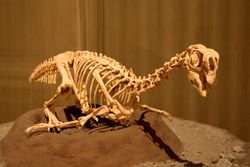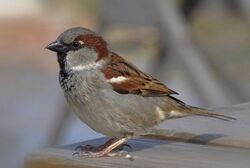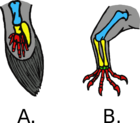Biology:Pennaraptora
| Pennaraptorans | |
|---|---|

| |
| Cast skeleton of Conchoraptor gracilis | |

| |
| House sparrow (Passer domesticus) | |
| Scientific classification | |
| Domain: | Eukaryota |
| Kingdom: | Animalia |
| Phylum: | Chordata |
| Clade: | Dinosauria |
| Clade: | Saurischia |
| Clade: | Theropoda |
| Clade: | Maniraptoriformes |
| Clade: | Maniraptora |
| Clade: | Pennaraptora Foth et al., 2014 |
| Subgroups | |
| Synonyms | |
| |
Pennaraptora (Latin penna "bird feather" + raptor "thief", from rapere "snatch"; a feathered bird-like predator) is a clade defined as the most recent common ancestor of Oviraptor philoceratops, Deinonychus antirrhopus, and Passer domesticus (the house sparrow), and all descendants thereof, by Foth et al., 2014.[1]
The clade "Aviremigia" was conditionally proposed along with several other apomorphy-based clades relating to birds by Jacques Gauthier and Kevin de Queiroz in a 2001 paper. Their proposed definition for the group was "the clade stemming from the first panavian with ... remiges and rectrices, that is, enlarged, stiff-shafted, closed-vaned (= barbules bearing hooked distal pennulae), pennaceous feathers arising from the distal forelimbs and tail".[2] Ancestral morphology relating to pennaceous feathers suggests that basal species of Pennaraptora were capable of scansorial locomotion and gliding, and further evolution of said adaptation within the clade would eventually give rise to the origin of flight in avian species.[3]
See also
References
- ↑ Foth, Christian; Tischlinger, Helmut; Rauhut, Oliver (2014). "New specimen of Archaeopteryx provides insights into the evolution of pennaceous feathers". Nature 511 (7507): 79–82. doi:10.1038/nature13467. PMID 24990749.
- ↑ Gauthier, J. and de Queiroz, K. (2001). "Feathered dinosaurs, flying dinosaurs, crown dinosaurs, and the name 'Aves'". Pp. 7-41 in Gauthier, J. and L.F. Gall (eds.), New Perspectives on the Origin and Early Evolution of Birds: Proceedings of the International Symposium in Honor of John H. Ostrom. New Haven: Peabody Museum of Natural History, Yale University. ISBN:0-912532-57-2.
- ↑ Sorkin, Boris (2021-12-02). "Scansorial and aerial ability in Scansoriopterygidae and basal Oviraptorosauria". Historical Biology 33 (12): 3202–3214. doi:10.1080/08912963.2020.1855158. ISSN 0891-2963. https://doi.org/10.1080/08912963.2020.1855158.
Wikidata ☰ Q4828939 entry
 |


